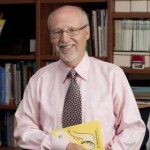The sound of music
Posted: June 21, 2013
Marshall L. Chasin, AuD, ’03, is banging the drum on hearing loss prevention among musicians. A mathematics and linguistics major turned audiologist, Dr. Chasin has spent nearly 30 years in the profession. With self-proclaimed tenacity, he holds numerous faculty appointments, is a weekly blogger, and is the author of six books. His 1996 book, “Musicians and the Prevention of Hearing Loss,” changed many audiologists’ tune on the topic.
Dr. Chasin mostly works with musicians in a preventative and rehabilitative manner. Since the ’80s he has volunteered with the National Youth Orchestra of Canada, an advanced orchestral training institute for musicians ages 16-28. In 2012, he received the Queen Elizabeth II Diamond Jubilee Medal for his volunteer services. The honor was presented by the governor general, Canada’s representative to the queen.
“I help musicians play their music safely so that 30-40 years down the road they don’t experience hearing loss,” says Dr. Chasin, a black belt who also teaches youth karate.
Keeping Canada’s young musicians healthy means providing specially-designed hearing protectors that allow them to hear their music at a safer level. They are taught to protect hearing by modifying their environment and are educated in sound moderation. Dr. Chasin says intensity is what damages hearing, not loudness.
“There is nothing wrong with listening to Beethoven or AC/DC or Kiss, but cool it the next day,” he advises. “Give the ears some reprieve. It’s intensity and duration together that causes damage.”
Dr. Chasin reminds musicians that more than just their vocation is potentially damaging to hearing. Lawn mowers, blow dryers, motorcycles, and vacuums can also erode the ear’s sensibilities.
“Musicians are more than just musicians—they are also riding their motorcycles and mowing their lawns,” he says. “All of these things can add up to hearing loss.”
Not only does Dr. Chasin work with musicians, he too is an instrumentalist, playing both the guitar and the clarinet.
“I thought I was a second-rate musician, but my son, who is a great musician, tells me I’m third-rate,” he jokes. “When I come back reincarnated I am going to come back as someone who can sing.”
Not one to play second fiddle, Dr. Chasin’s inquisitive nature continues to amplify the discipline. As director of auditory research at the Musician’s Clinics of Canada in Toronto, coordinator of research at the Canadian Hearing Society, and director of research at ListenUp Canada, he has spent the last 15 years researching language and how to adjust a hearing aid to receive, for example, English versus Turkish.
He also volunteers with Toronto’s homeless population, who, he says, has statistically greater hearing loss than the nonhomeless (approximately 10 percent versus one percent).
It must be his tenacity and inquisitiveness that keeps this hearing advocate so busy. After all, Dr. Chasin decided to get his doctorate from ATSU after practicing for more than two decades.
“2003 was an interesting year for me. It was nice to remind myself of things that I had forgotten. For that, I loved the program,” he says.